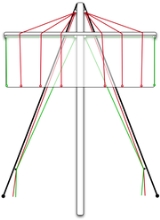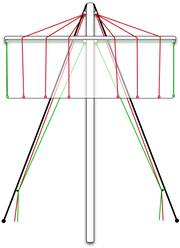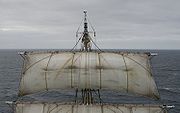
Clewlines and buntlines
Encyclopedia
For the revolver, see Colt Buntline
Clewlines and buntlines are lines used to handle the sail
s of a square rig
ged ship.
 Although the common perception of a traditionally rigged ship is that the sails are handled from "up in the rigging", the majority of the work is actually carried out from the deck. In particular, when sailors go aloft to stow the square sails by bundling them up and tying them to the yard
Although the common perception of a traditionally rigged ship is that the sails are handled from "up in the rigging", the majority of the work is actually carried out from the deck. In particular, when sailors go aloft to stow the square sails by bundling them up and tying them to the yard
(with gasket
s) they don't have to pull the whole weight of the sail up towards them. That work has already been carried out from the deck using the clewlines and the buntlines.
As the name suggests, clewlines are attached to the outer corners or clews of the sail. They lift more weight than the buntlines, and also have to pull against the sheet
s - although these will have been released there is still a certain amount of friction produced by the blocks and fairlead
s that they run through. For this reason the clewlines are usually fitted with block
s to increase the mechanical advantage
. The clewlines are coloured green in the diagram, and run along the underside of the yard from the outboard ends to the mast, and then down to the deck.
Buntlines lift the middle portion of the sail; there will usually be four to eight buntlines across the foot of the sail. Traditionally they are secured to the sail with buntline hitch
es. Since buntlines only have to lift a section of canvas, they can be thinner than the clewlines and are not usually fitted with a purchase. A typical arrangement for the buntlines has them running through deadeye
s on the yard, upwards to a block fixed to the shrouds a little higher up the mast, and then downwards against the inside of the ratlines
to the deck. This provides a good lead but does create a minor obstacle to sailors moving out along the yards.
 Both clewlines and buntlines are commonly led to the deck against the inside of the ratlines. With six or so buntlines and two clewlines per sail, a ship with five sails per mast will have a lot of lines (note, though, that clewlines and buntlines go to both sides of the deck, so at each set of shrouds there will only be four lines per sail). It is usual to fit a wooden bar near the bottom of the ratlines, with a hole for each clewline or buntline, to keep them organised. The traditional layout is to have the lines from each sail grouped together, starting from the forward end with the clewline and then the buntlines. This will be followed by the clewline of the next sail, and so on - the clewlines and hence the division between sails can be distinguished by their thickness. The lowest sail's lines will be at the forward end of the rail, and the highest will be at the aft end. There may not be an individual belaying pin
Both clewlines and buntlines are commonly led to the deck against the inside of the ratlines. With six or so buntlines and two clewlines per sail, a ship with five sails per mast will have a lot of lines (note, though, that clewlines and buntlines go to both sides of the deck, so at each set of shrouds there will only be four lines per sail). It is usual to fit a wooden bar near the bottom of the ratlines, with a hole for each clewline or buntline, to keep them organised. The traditional layout is to have the lines from each sail grouped together, starting from the forward end with the clewline and then the buntlines. This will be followed by the clewline of the next sail, and so on - the clewlines and hence the division between sails can be distinguished by their thickness. The lowest sail's lines will be at the forward end of the rail, and the highest will be at the aft end. There may not be an individual belaying pin
for each line; since the buntlines are invariably worked together several of them may be secured to the same pin.
Some sails, in addition to clewlines and buntlines, have leechlines to pull the edges into the centre when they are stowed (see picture). However, these can be treated exactly like buntlines, and it is generally not possible to identify a leechline from the deck.
Because the clewlines, and especially the buntlines, do not pass through the axis on which the yard pivots, their effective length will change as the yard is rotated round the mast from one tack to the other. When the sail is set, the lines can be left with plenty of slack to allow for this; if the sail is currently in its gear (see yardarm) then it might be necessary to tend the lines as the yards are braced round.
Colt Buntline
The Colt Buntline Special is a variant of long-barreled Colt Single Action Army revolver that author Stuart N. Lake created while writing his 1931 biography of Wyatt Earp. According to Lake's biography, Wyatt Earp: Frontier Marshal published in 1931, dime novelist Ned Buntline had five Buntline...
Clewlines and buntlines are lines used to handle the sail
Sail
A sail is any type of surface intended to move a vessel, vehicle or rotor by being placed in a wind—in essence a propulsion wing. Sails are used in sailing.-History of sails:...
s of a square rig
Square rig
Square rig is a generic type of sail and rigging arrangement in which the primary driving sails are carried on horizontal spars which are perpendicular, or square, to the keel of the vessel and to the masts. These spars are called yards and their tips, beyond the last stay, are called the yardarms...
ged ship.

Yard (sailing)
A yard is a spar on a mast from which sails are set. It may be constructed of timber, steel, or from more modern materials, like aluminium or carbon fibre. Although some types of fore and aft rigs have yards , the term is usually used to describe the horizontal spars used with square sails...
(with gasket
Gasket (sailing)
In sailing, gaskets are lengths of rope or fabric used to hold a stowed sail in place. In modern use, the term is usually restricted to square-rigged ships, the equivalent items on yachts being referred to by the more prosaic "sail ties"....
s) they don't have to pull the whole weight of the sail up towards them. That work has already been carried out from the deck using the clewlines and the buntlines.
As the name suggests, clewlines are attached to the outer corners or clews of the sail. They lift more weight than the buntlines, and also have to pull against the sheet
Sheet (sailing)
In sailing, a sheet is a line used to control the movable corner of a sail.- Fore-and-aft rigs:Fore-and-aft rigs comprise the vast majority of sailing vessels in use today, including effectively all dinghies and yachts. The sheet on a fore-and-aft sail controls the angle of the sail to the wind,...
s - although these will have been released there is still a certain amount of friction produced by the blocks and fairlead
Fairlead
A fairlead is a device to guide a line, rope or cable around an object, out of the way or to stop it from moving laterally. Typically a fairlead will be a ring or hook. The fairlead may be a separate piece of hardware, or it could be a hole in the structure....
s that they run through. For this reason the clewlines are usually fitted with block
Block (sailing)
In sailing, a block is a single or multiple pulley. One or a number of sheaves are enclosed in an assembly between cheeks or chocks. In use a block is fixed to the end of a line, to a spar or to a surface...
s to increase the mechanical advantage
Mechanical advantage
Mechanical advantage is a measure of the force amplification achieved by using a tool, mechanical device or machine system. Ideally, the device preserves the input power and simply trades off forces against movement to obtain a desired amplification in the output force...
. The clewlines are coloured green in the diagram, and run along the underside of the yard from the outboard ends to the mast, and then down to the deck.
Buntlines lift the middle portion of the sail; there will usually be four to eight buntlines across the foot of the sail. Traditionally they are secured to the sail with buntline hitch
Buntline hitch
The buntline hitch is a knot used for attaching a rope to an object. It is formed by looping the rope around an object, then making a clove hitch around the rope's standing part, taking care to tie the two half-hitches that compose the clove hitch in the direction of the object, rather than away...
es. Since buntlines only have to lift a section of canvas, they can be thinner than the clewlines and are not usually fitted with a purchase. A typical arrangement for the buntlines has them running through deadeye
Deadeye
A deadeye is an item used in the standing and running rigging of traditional sailing ships. It is a smallish round thick wooden disc with one or more holes through it, perpendicular to the plane of the disc. Single and triple-hole deadeyes are most commonly seen...
s on the yard, upwards to a block fixed to the shrouds a little higher up the mast, and then downwards against the inside of the ratlines
Ratlines
Ratlines, pronounced "rattlin's", are lengths of thin line tied between the shrouds of a sailing ship to form a ladder. Found on all square rigged ships, whose crews must go aloft to stow the square sails, they also appear on larger fore-and-aft rigged vessels to aid in repairs aloft or conduct a...
to the deck. This provides a good lead but does create a minor obstacle to sailors moving out along the yards.

Belaying pin
A belaying pin is a device used on traditional sailing vessels to secure lines of rigging. Their function on modern vessels has been replaced by cleats, but they are still used, particularly on square rigged ships....
for each line; since the buntlines are invariably worked together several of them may be secured to the same pin.
Some sails, in addition to clewlines and buntlines, have leechlines to pull the edges into the centre when they are stowed (see picture). However, these can be treated exactly like buntlines, and it is generally not possible to identify a leechline from the deck.
Because the clewlines, and especially the buntlines, do not pass through the axis on which the yard pivots, their effective length will change as the yard is rotated round the mast from one tack to the other. When the sail is set, the lines can be left with plenty of slack to allow for this; if the sail is currently in its gear (see yardarm) then it might be necessary to tend the lines as the yards are braced round.

